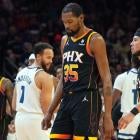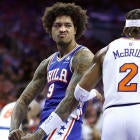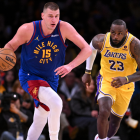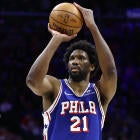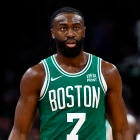Don't give up shots at the basket. That seems to be the No. 1 goal for any defensive scheme in the NBA. Layups and dunks are generally the most efficient shots in the NBA, so you want to make sure you don't allow teams to get to the rim, but that's easier said than done. It helps having a shot blocker in the middle of the defense because that can be a huge deterrent, but not every team is blessed with having one of those guys on their team.
Figuring out how good a rim protector can be isn't a simple process. Simply blocking shots is a fun stat but it doesn't necessarily give the picture of how helpful you are to your defense. We're going to pull in a bunch of stats (none of them including blocked shots) in the hopes of providing a complete picture.
Again, none of this is an exact science but we're going to look at the differential in defensive rating (on/off the court), shots at the rim defended per 36 minutes and their field goal percentage (per NBA.com/stats), the differential between how often shots in the restricted area are attempted (on/off the court), and the differential in percentage of those restricted area shots (on/off the court). We'll also take the "points saved per 36 minutes" metric from Nylon Calculus, as well.
There can be a lot of noise in each of these stats so take each one with a grain of salt. They're merely all given in order to provide as much information as possible. It's also important to note that some of the percentages allowed in the restricted area for a team can likely be better when these rim protectors aren't on the floor because they're going against second units that aren't as good at scoring, and vice-versa.
Finding ways to make up for that lack of a rim protector can be tricky, but it's certainly doable. We're going to take a look at all 30 teams in the NBA and how they did last season with their main rim protector. We'll also try to project how that team will be for rim protection this coming season.
 Atlanta Hawks: Al Horford
Atlanta Hawks: Al Horford
| Player | Def Rtg Diff. | Rim FG/36 Def. | Rim Def. FG% | RA Rate Diff. | RA FG% Diff. | Points Saved/36 |
| Horford | -1.8 per 100 | 9.3 FGA per 36 | 49.4% | -3.7% | +1.1% | 0.15 Pts per 36 |
How they were last season: The Atlanta Hawks had the second-best defense in the NBA last season and gave up just 98.2 points per 100 possessions with Al Horford on the floor. He and Paul Millsap defended about the same number of shots at the rim, and Horford was mostly fine at it. He didn't save a ton of points, according to Nylon Calculus' model, but the Hawks did give up 3.7 percent fewer attempts in the restricted area when Horford was on the floor. He wasn't a huge deterrent, but he was still good enough to operate successfully in that good Hawks system.
How they project for this season: Horford bolted for Boston, and now the Hawks will replace him with Dwight Howard (more on him in the Rockets' section). They're not getting the same Howard who won three straight Defensive Player of the Year awards. The back injuries, the knee trouble, and the shoulder injuries have worn down his body quite a bit, but he's still capable of being effective. He was on a listless Houston Rockets team last year and we saw his rim protection take a huge hit. His rim attempts defended and points saved metrics both dropped significantly from 2014-15 to 2015-16. Is it because he was too old/banged up or because the Rockets just made defense too hard?
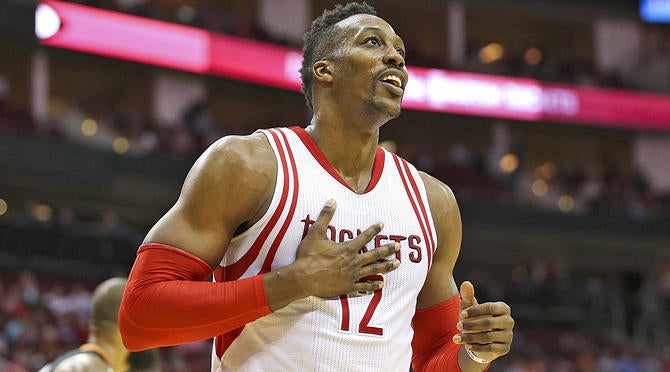
We should see a reinvigorated Howard on the defensive side of the ball, assuming he can remain healthy. Putting him in the Hawks' system means he won't have to cover nearly as much. The return of Tiago Splitter from the hip surgery also means Howard's minutes won't wear him down. Mike Budenholzer values rest and will ask more of Howard while playing him a more manageable amount of time on the floor.
 Boston Celtics: Amir Johnson
Boston Celtics: Amir Johnson
| Player | Def Rtg Diff. | Rim FG/36 Def. | Rim Def. FG% | RA Rate Diff. | RA FG% Diff. | Points Saved/36 |
| Johnson | +0.7 per 100 | 9.3 FGA per 36 | 47.4% | -2.3% | +2.9% | 0.10 Pts per 36 |
How they were last season: The Boston Celtics had a top 5 defense this past season without a superior big man protecting the rim. Part of this was due to having guys like Avery Bradley, Marcus Smart, and Jae Crowder defending the perimeter. It's going to be hard to dribble to the basket when the defender is closer than the stitching on your jersey. But Amir Johnson did a good job of protecting the rim and only played about 23 minutes per game. The NBA.com/stats had Johnson allowing about 47.4 percent at the rim. Synergy Sports has it at 42.3 percent in defending "around the basket (non post-ups)."
They gave up a higher success rate in the restricted area with Johnson by nearly three percent but they also allowed 2.3 percent fewer attempts in the restricted area with him on the floor. That could be because of the caliber of perimeter defenders he was playing with not allowing guys to get to the rim, but Brad Stevens also used enough variations in lineups to even that out across the board. Johnson was solid but they should be even better this time.
How they project for this season: Hey, remember Al Horford from just one section before this? Well, he's on the Celtics now and it should only make their defense better this season. That's a scary thought for opponents. Horford is solid and playing with better perimeter defenders in Bradley, Smart, and Crowder could make this the top defense in the NBA. You'll still have Johnson in the rotation for Boston and Kelly Olynyk will be able to play with either big man. But essentially replacing Jared Sullinger with a great big defender like Horford, who can defend inside and the perimeter, will make this team a nightmare to score against, especially if you do manage to get into the interior of the defense.
 Brooklyn Nets: Brook Lopez
Brooklyn Nets: Brook Lopez
| Player | Def Rtg Diff. | Rim FG/36 Def. | Rim Def. FG% | RA Rate Diff. | RA FG% Diff. | Points Saved/36 |
| B. Lopez | -5.6 per 100 | 10.3 FGA per 36 | 47.0% | -1.2% | -0.5% | 0.82 Pts per 36 |
How they were last season: Brook Lopez isn't thought of as one of the better rim protectors in the league because he's a slow, plodding big man who puts up big scoring numbers. However, Lopez has become a very reliable rim protector over the last couple of years, as long as he's healthy. This past season is tough to judge because the Brooklyn Nets were such a mess on the court, but Lopez's impact can be seen across the board. They were 5.6 points per 100 possessions better defensively with him on the floor, he defended double-digit shot attempts at the rim per 36 minutes and did a good job of allowing a low percentage, and the Nets gave up fewer attempts in the restricted area when he was on the floor.
How they project for this season: This defense is probably going to be pretty bad, but I can't imagine it's going to be the second-worst defense in the NBA like we saw last season. Lopez is a solid enough anchor, and they've upgraded the roster with veterans who will know how to play solid defense. New coach Kenny Atkinson is coming in from that Hawks defense that was so good last season, and he'll demand improvement right away as he develops these guys further. They just need Lopez to remain healthy.
 Charlotte Hornets: Cody Zeller
Charlotte Hornets: Cody Zeller
| Player | Def Rtg Diff. | Rim FG/36 Def. | Rim Def. FG% | RA Rate Diff. | RA FG% Diff. | Points Saved/36 |
| Zeller | +2.6 per 100 | 8.7 FGA per 36 | 48.1% | -0.6% | +5.0% | 0.67 Pts per 36 |
How they were last season: It's surprising that Cody Zeller logged the most rim protection attempts this past season for the Charlotte Hornets because he doesn't have a reputation as much of a rim protector and the Hornets were such a good defensive team (ninth in the NBA). But Steve Clifford's defensive schemes don't normally require a classic rim protector. The perimeter defense is so good and the positioning of the team is so precise that they often keep you away from the rim just with rotations. The Hornets were worse with Zeller on the floor defensively, but they were still solid with him on the floor. He also was good at protecting the rim and saving points, via the points saved metric.
How they project for this season: This is where it gets interesting for Charlotte and Clifford. They've signed Roy Hibbert (more on him in the Lakers' section) on a modest, one-year contract. Clifford is pretty openly opposed to putting value into steals and blocked shots as measurements of defense. He thinks they're overrated statistics. It wasn't that long ago that Hibbert was considered one of the best rim protectors in the league and his verticality was the standard when guys attacked him at the rim. Clifford finding a good balance between his team's rotations and rediscovering Hibbert's effectiveness protecting the rim could put this team Top 5 in defensive rating by the end of the season.
 Chicago Bulls: Pau Gasol
Chicago Bulls: Pau Gasol
| Player | Def Rtg Diff. | Rim FG/36 Def. | Rim Def. FG% | RA Rate Diff. | RA FG% Diff. | Points Saved/36 |
| P. Gasol | -1.0 per 100 | 12.1 FGA per 36 | 46.3% | -0.8% | +3.5% | 1.87 Pts per 36 |
How they were last season: This is going to sound crazy but despite the slowness, bad feet, and age, Pau Gasol was a really good rim protector. Individually, he was very solid and the Chicago Bulls were a point per 100 possessions better with him on the floor. Gasol actually defended over 12 shots at the rim per 36 minutes, which is one of the highest rates of the guys mentioned here. And allowing just 46.3 percent (again, this stat has noise but is still solid) at the rim is actually a better percentage than Tim Duncan this past season. Synergy Sports had Gasol allowing 41.4 percent around the basket (non post-ups).
There were still problems with Gasol as a defender and even a rim protector at times, but he used his length and experience to be pretty effective around the tin for the Bulls.
How they project for this season: Gasol is gone, Joakim Noah is gone, and Robin Lopez is in (more on him in the Knicks' section). Lopez was an effective rim protector as well by most of these numbers this past season, but the Knicks did allow more points per 100 possessions with him on the floor than without him. If Rajon Rondo can stay in front of his man and Dwyane Wade plays solid defense, Lopez won't have to over extend himself defensively. This should leave to effective rim protection from him, but it will all start with that backcourt. If they don't defend, Lopez will have too much to cover on a nightly basis.
 Cleveland Cavaliers: Tristan Thompson
Cleveland Cavaliers: Tristan Thompson
| Player | Def Rtg Diff. | Rim FG/36 Def. | Rim Def. FG% | RA Rate Diff. | RA FG% Diff. | Points Saved/36 |
| Thompson | -1.3 per 100 | 8.1 FGA per 36 | 52.8% | -3.5% | -4.4% | -0.56 Pts per 36 |
How they were last season: The Cleveland Cavaliers are an interesting case study here because their rim protector from the past season became a hot pile of ineffectiveness in 2015-16. The Timofey Mozgov we saw after the Cavs traded for him wasn't anywhere to be found and that forced Tristan Thompson into the role as the main center on the team. While he didn't do a very good job of protecting the rim, the Cavs were better defensively with him on the floor and they gave up fewer attempts at the rim when he was in the game. Cleveland's perimeter defenders (mostly LeBron James and J.R. Smith) did a fantastic job of keeping guys out of the paint and away from the rim. Once they missed, Thompson's most effective mode of defense was ending the possession by grabbing a rebound.
He wasn't a good rim protector and the Cavs still managed to get by and have a top 10 defense.
How they project for this season: Thompson isn't a traditional shot blocker or rim protector, and he failed to save points at the rim. However, this will be his first real, steady role as one on a good team from start to finish in a season. It shouldn't be a surprise if he gets better at it this season as the Cavs defender their championship and ask him to be that guy in the paint. The Cavs should still be a top 10 defense and if Thompson does provide a more effective rim protection, they'll be in great shape once again for the postseason run.
 Dallas Mavericks: Zaza Pachulia
Dallas Mavericks: Zaza Pachulia
| Player | Def Rtg Diff. | Rim FG/36 Def. | Rim Def. FG% | RA Rate Diff. | RA FG% Diff. | Points Saved/36 |
| Pachulia | -2.1 per 100 | 9.9 FGA per 36 | 52.2% | -5.9% | -5.6% | 0.08 Pts per 36 |
How they were last season: You won't see good individual rim protection numbers from Zaza Pachulia last season. He allowed 52.2 percent at the rim and his Synergy Sports measurements were even worse (55 percent). He barely saved points too. However, Rick Carlisle's team was over two points per 100 possessions better with Zaza on the floor and they gave up nearly six percent fewer attempts in the restricted area when he was on the floor. Pachulia didn't block shots but his big body and presence was still relatively effective when coupled with above average perimeter defense.
How they project for this season: The Mavericks should be much better with rim protection this coming season. Pachulia is gone and they've brought in Andrew Bogut in the wake of Kevin Durant signing with the Golden State Warriors (more on Bogut in a couple of sections). As long as Bogut is healthy, he'll be the same elite rim protector that he was in Golden State, even if he isn't playing a heavy workload of minutes. Mavs were middle of the road in defensive rating this past season. Having an elite rim protector will really boost that.
 Denver Nuggets: Nikola Jokic
Denver Nuggets: Nikola Jokic
| Player | Def Rtg Diff. | Rim FG/36 Def. | Rim Def. FG% | RA Rate Diff. | RA FG% Diff. | Points Saved/36 |
| Jokic | -6.2 per 100 | 9.2 FGA per 36 | 49.3% | +0.2% | -0.7% | 0.31 Pts per 36 |
How they were last season: Nikola Jokic is one of three rookies highlighted as the main rim protector in this post and his numbers from his first season were impressive. It's hard to know if 49.3 percent allowed at the rim is good for a rookie or not because we don't have a big history of this stat (just about three years publicly), but anything under 50 percent for a rookie big man seems good. Synergy Sports had him at 50.4 percent around the basket (non post-ups), but that still sounds more than acceptable. The Nuggets were much better defensively with him on the floor, but there wasn't much of a change in terms of attempts allowed in the restricted area and percentage. He didn't save a ton of points at the rim, but he was still firmly in the positive.
How they project for this season: The biggest question about anything Jokic did last season is he didn't play a lot of minutes. Michael Malone kept him under 22 minutes per game, so knowing whether or not he can be a guy just as effective as someone with a heavy workload of minutes remains to be seen. But you also have to consider that he'll now be more adjusted to the pace of the game, stronger, and smarter about schemes with some experience. Even if his production defensively dips a bit more with heavier minutes, it probably evens out since he'll be more adjusted to the NBA game. He could be the key between the Nuggets being a league average defense or in the bottom 7 like they were last season.
 Detroit Pistons: Andre Drummond
Detroit Pistons: Andre Drummond
| Player | Def Rtg Diff. | Rim FG/36 Def. | Rim Def. FG% | RA Rate Diff. | RA FG% Diff. | Points Saved/36 |
| Drummond | -3.4 per 100 | 9.3 FGA per 36 | 52.6% | +6.2% | +0.4% | -0.10 Pts per 36 |
How they were last season: Maybe this surprises people but Andre Drummond, despite his size and athleticism, is a poor rim protector. Just about every metric available paints him in that light. He doesn't save points, he doesn't protect the rim well, and the Pistons end up giving up more attempts in the restricted area when he's on the floor than when he's on the bench. Synergy has Drummond at 54 percent allowed at the rim too. Generally, he's defending the pick-and-roll and he doesn't show and recover to the paint all that well. Some of this could be conditioning. Some of this could be his workload on offense. Some of this could be he just needs more time under Stan Van Gundy to get better.
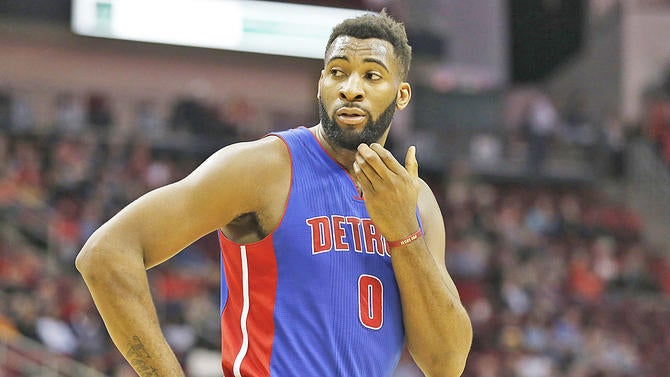
How they project for this season: This fully depends on how much Drummond improves as a rim protector. The scheme is good. The perimeter defenders are good. Guys like Kentavious Caldwell-Pope and Stanley Johnson can be terrors for opposing wings. But the Dwight Howard comparisons we threw on Drummond soon after SVG took over the Pistons end 100 percent on the defensive end of the floor. If Drummond makes the leap protecting the rim, this can be a great defense (13th last season).
 Golden State Warriors: Andrew Bogut
Golden State Warriors: Andrew Bogut
| Player | Def Rtg Diff. | Rim FG/36 Def. | Rim Def. FG% | RA Rate Diff. | RA FG% Diff. | Points Saved/36 |
| Bogut | -5.8 per 100 | 11.1 FGA per 36 | 45.2% | -1.0% | +2.9% | 2.10 Pts per 36 |
How they were last season: Andrew Bogut is awesome defending the rim. He's big and strong so he doesn't get knocked out of position by contact. He's intelligent with the way he challenges shots, so his declining athleticism doesn't become an issue. His timing is fantastic and it helps that he played with great defenders like Draymond Green, Andre Iguodala, and Klay Thompson. Bogut only played about 20 minutes per game but he challenged a lot of shots during those 20 minutes. He allowed just 45.2 percent at the rim (Synergy has him at a ridiculously low 35.2 percent) and he saved over two points per 36 minutes. He was yet another unbelievable weapon on a team that won 73 games and almost won the title.
How they project for this season: Bogut is gone. He was a casualty of the Durant signing, but the Warriors rebounded by getting Zaza Pachulia on a one-year deal. Remember Pachulia from the Mavs section as a big body who helped deter shots inside but didn't do a great job once the shooter was around the basket? Could having those amazing defenders on the wings and Draymond Green helping him inside instead of Dirk Nowitzki turn Pachulia into an above average rim protector? The Warriors hope so.
 Houston Rockets: Dwight Howard
Houston Rockets: Dwight Howard
| Player | Def Rtg Diff. | Rim FG/36 Def. | Rim Def. FG% | RA Rate Diff. | RA FG% Diff. | Points Saved/36 |
| Howard | -1.2 per 100 | 8.0 FGA per 36 | 49.7% | -0.2% | +1.8% | -0.66 Pts per 36 |
How they were last season: If you have any shaking head .gifs on your computer or smart phone, just imagine one of them here instead. If you don't, let's quickly go over how poor the Houston Rockets were defensively and protecting the rim. Howard was signed years ago to be the guy who made up for all of the bad defense from the perimeter. And the Rockets were 1.2 points per 100 possessions better with him on the floor, but they still gave up 105.1 points per 100 with him playing. His 49.7 percent allowed at the rim was four percent worse than the 2014-15 season. He didn't save points at all. He couldn't make up for the bad defensive efforts of James Harden and Trevor Ariza.
There are plenty of reasons why the Rockets didn't want him back, but this is certainly a big one. If he can't fix your defense, is it worth paying him all that money?
How they project for this season: As bad as it was last season, it could be much worse this season. The Rockets hired Mike D'Antoni, signed guys like Eric Gordon and Ryan Anderson, and are relying on Clint Capela to be their only real presence at the rim defensively. Capela challenged a lot more shots last season (11.4 per 36 minutes) and allowed 49.3 percent at the rim. But unless the Rockets improve their consistency on the perimeter, there might just be too much for a young big like Capela to make up for.
 Indiana Pacers: Myles Turner
Indiana Pacers: Myles Turner
| Player | Def Rtg Diff. | Rim FG/36 Def. | Rim Def. FG% | RA Rate Diff. | RA FG% Diff. | Points Saved/36 |
| Turner | +0.6 per 100 | 11.2 FGA per 36 | 50.7% | -3.0% | +2.3% | 1.06 Pts per 36 |
How they were last season: Myles Turner is our second rookie here and he already looks to be a pretty superb rim protector. He had some of the more entertaining shot block highlights last season, and he contested a ton of shots. The Pacers gave up three percent fewer attempts when he was on the floor and his 50.7 percent allowed at the rim was acceptable for a rookie (especially if you go by Synergy's 44.4 percent for him around the basket). He saved just over a point per 36 minutes, which definitely seems good for a rookie big man.
How they project for this season: Turner, much like Jokic, should be able to handle a bigger workload this season, as long as he's healthy (22.8 minutes per game and missed 22 games). The Pacers have added Jeff Teague, Thaddeus Young, and Al Jefferson to bolster the experience on the roster, but Turner is the sole rim protector on the team. Now that he's more adjusted to the NBA style of play, expect him to start moving toward becoming one of the better rim protectors in the NBA.
 Los Angeles Clippers: DeAndre Jordan
Los Angeles Clippers: DeAndre Jordan
| Player | Def Rtg Diff. | Rim FG/36 Def. | Rim Def. FG% | RA Rate Diff. | RA FG% Diff. | Points Saved/36 |
| Jordan | -1.9 per 100 | 8.5 FGA per 36 | 46.4% | -1.5% | +6.2% | 0.51 Pts per 36 |
How they were last season: Two straight years we've seen DeAndre Jordan voted to the All-Defensive First Team, and this past season couldn't have been more deserving. The Clippers tweaked their pick-and-roll coverage, which actually put more pressure on Jordan to show and recover than he ever had, and he responded by being a monster defensive presence. His points saved numbers weren't spectacular but he still saved a half point per game. He allowed 46.4 percent at the rim, according to NBA.com, and 42.4 percent around the basket, according to Synergy. It's a bit surprising he didn't defend double-digit attempts per 36 minutes, but Jordan was a monster. He truly affects the game and has guys second guessing whether or not they should attack the basket.
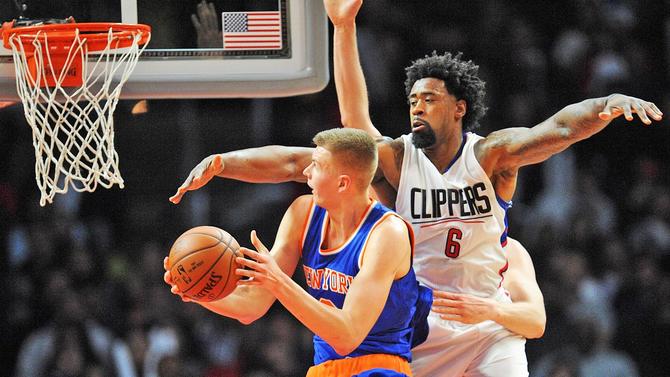
How they project for this season: You would assume they should be better. The addition of Luc Mbah a Moute to the starting lineup gave the Clippers a real boost on the perimeter. Getting Blake Griffin back could end up putting more pressure and responsibility on Jordan, unless Griffin can continue to improve as a defender. Jordan's improvement on that end of the floor is also now coupled with his incredible experience with Team USA this summer. Expect another big season from him on that end of the floor.
 Los Angeles Lakers: Roy Hibbert
Los Angeles Lakers: Roy Hibbert
| Player | Def Rtg Diff. | Rim FG/36 Def. | Rim Def. FG% | RA Rate Diff. | RA FG% Diff. | Points Saved/36 |
| Hibbert | +6.2 per 100 | 9.7 FGA per 36 | 50.6% | -2.7% | -4.8% | -0.33 Pts per 36 |
How they were last season: Three years ago, Roy Hibbert allowed just 40.9 percent at the rim. Two years ago, he allowed just 42.7 percent at the rim. In his first year away from the Indiana Pacers and with the Los Angeles Lakers, Hibbert looked like a completely ordinary defensive big man. He didn't save points. He allowed over 50 percent at the rim. The defense was six points per 100 possessions worse with him on the floor. It was really bad and not the way you want to approach a contract season. Granted, this Lakers team sucked, they were the worse defense in the NBA, and he didn't have much resistance in front of him. But he needed to be much better.
How they project for this season: Hibbert is out and they've signed Timofey Mozgov to a four-year, $64 million deal. Mozgov -- you may remember from earlier -- was horrendous for the Cavs this past season. He was less effective at the rim (47.4 percent down to 48.5 percent) and Synergy Sports had him going from allowing 28.9 percent to 51.5 percent around the basket from 14-15 to 15-16. The Lakers certainly hope they're paying for the 2014-15 version of Mozgov rather than last season, but either one will be an upgrade from what they saw out of Hibbert this past season. Adding Luol Deng to the mix should help cutting off free drives to the basket too.
 Memphis Grizzlies: Marc Gasol
Memphis Grizzlies: Marc Gasol
| Player | Def Rtg Diff. | Rim FG/36 Def. | Rim Def. FG% | RA Rate Diff. | RA FG% Diff. | Points Saved/36 |
| M. Gasol | -4.5 per 100 | 7.3 FGA per 36 | 45.7% | -6.7% | -3.3% | -0.15 Pts per 36 |
How they were last season: There is a lot of noise specifically with the Marc Gasol numbers because of the way the season ended for the Memphis Grizzlies. They went from being a pretty good team in the West to being one of the weirdest rosters in the NBA, simply due to the injuries. By the end of the season, they were piecing together whatever lineup they could and were even desperate enough to sign Jordan Farmar. But Gasol was still very good defensively and a pretty solid rim protector. He didn't save points, but he defended the rim pretty well. He's also much more of a guy who covers for others and switches to the perimeter, so it makes sense that he had so few attempts at the rim to defend.
How they project for this season: They'll be really good, as long as Gasol stays healthy. His foot injury from last year is a concerning one because guys his size can really go through some rough stretches of health once they start needing foot surgery. But this is still a group with good perimeter defenders who can make it much harder to get to the rim. That helps Gasol be even more effective once they get there.
 Miami Heat: Hassan Whiteside
Miami Heat: Hassan Whiteside
| Player | Def Rtg Diff. | Rim FG/36 Def. | Rim Def. FG% | RA Rate Diff. | RA FG% Diff. | Points Saved/36 |
| Whiteside | +0.3 per 100 | 12.9 FGA per 36 | 46.9% | +0.3% | -0.6% | 2.80 Pts per 36 |
How they were last season: This is maybe the toughest player to judge in this respect. He was by far the best shot blocker in the NBA, but his defensive impact was consistently in question because he seemed to gamble more on blocking shots than protecting the rim, if that makes sense. He defended a lot of shots at the rim and his 46.9 percent allowed was slightly better than Duncan. He also saved nearly three points per 36 minutes (second in the NBA) But the Heat were slightly worse defensively when he was on the floor.
Opposing teams were actually happy he was on the floor, as long as they could suck him into playing pick-and-roll defense. That makes his rim protection a bit confusing in terms of how much impact it has on the game. But he was still the best shot blocker. We'll have a much better idea of the way his defense impacts a game this season.
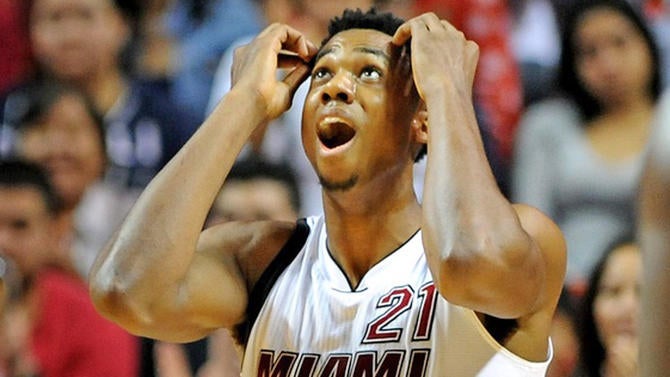
How they project for this season: A lot of this depends on the health of Chris Bosh. Losing a quality defender like Deng this offseason is tough. More minutes for Justise Winslow could help absorb that loss, but they need everybody defending well around Whiteside to guarantee he has the maximum impact possible. If he can be less of a shot chaser and just a guy who lets the offense attack him and then he attacks the shot, he could have legitimate Defensive Player of the Year potential -- and not just based off cool, archaic shot blocking numbers.
 Milwaukee Bucks: Greg Monroe
Milwaukee Bucks: Greg Monroe
| Player | Def Rtg Diff. | Rim FG/36 Def. | Rim Def. FG% | RA Rate Diff. | RA FG% Diff. | Points Saved/36 |
| Monroe | +4.3 per 100 | 9.3 FGA per 36 | 51.5% | +2.1% | +2.6% | -0.65 Pts per 36 |
How they were last season: Is Greg Monroe the worst rim protector of the bunch here? This is what I keep asking myself, and even if his data doesn't necessarily point to him as the worst, he's certainly in the conversation. There are plenty of pluses to his game, but rim protection certainly isn't one of them. He was a big reason why the Milwaukee Bucks' defense dropped from fourth in 2014-15 to 22nd this past season. He doesn't save points. The defense is much worse with him on the floor. He allows a high percentage at the rim and his Synergy Sports number (53.5 percent) is even worse. The Bucks need him but they have to find a better balance for him as a rim protector.
How they project for this season: Hopefully the Bucks will be better. The beauty of their defense two seasons ago was they switched everything, used their length, and cut off the basket quite a bit. We didn't see as much last season, as they were often starting two net negatives (Monroe and Michael Carter-Williams) on a nightly basis. But where they can improve defensively is with their versatility and length cutting off the floor. By giving Monroe fewer opportunities to protect the rim, they can improve greatly as a rim protecting team.
 Minnesota Timberwolves: Karl-Anthony Towns
Minnesota Timberwolves: Karl-Anthony Towns
| Player | Def Rtg Diff. | Rim FG/36 Def. | Rim Def. FG% | RA Rate Diff. | RA FG% Diff. | Points Saved/36 |
| Towns | +3.1 per 100 | 10.0 FGA per 36 | 49.6% | -2.3% | -0.4% | 1.01 Pts per 36 |
How they were last season: The third rookie on this list, Karl-Anthony Towns took the league by storm in his first season. But curiously, the Minnesota Timberwolves were much worse with him on the floor. A lot of this had to do with the final 2.5 months of the season when they were offensive juggernauts and red carpets on defense. They went with the youth movement during that time and got torched from 3-point range. When Towns was challenged at the rim, he held his own. Like Turner and Jokic, his percentage allowed at the rim looks pretty good for a rookie. His Synergy numbers put him at a very impressive 42.9 percent allowed around the rim, which is much more in line with his points saved per 36 metric.
How they project for this season: Take all of the poor habits of the Wolves' defense last season and light them on fire. Tom Thibodeau has taken over and this team will be held accountable in very real ways for every mistake they make defensively. It will take some time for the young guys to grasp it, but Towns may benefit more than anybody on the team. He projects to be one of the best defensive big men in the NBA pretty soon and with Thibodeau's coaching, that process should be accelerated. However, he needs help from the perimeter defense to not leave him having to cover up too much.
 New Orleans Pelicans: Anthony Davis
New Orleans Pelicans: Anthony Davis
| Player | Def Rtg Diff. | Rim FG/36 Def. | Rim Def. FG% | RA Rate Diff. | RA FG% Diff. | Points Saved/36 |
| Davis | +0.1 per 100 | 6.1 FGA per 36 | 47.7% | -0.4% | +1.9% | -0.16 Pts per 36 |
How they were last season: Anthony Davis is another rim protector who is pretty difficult to properly judge. He's expected to be this otherworldly defensive force and there are times he is. There are also times in which he doesn't really impact the defense in a positive way at all. Is this the scheme? Is this the injuries to his team? Is it the general personnel around him? Whatever the reason, he wasn't a strong influence protecting the rim last season. He didn't save points and his Synergy percentage allowed around the basket was 52.6 percent. It's also weird seeing how few shots at the rim he defended per 36 minutes, but he was often trying to swarm on the perimeter and be everywhere.
How they project for this season: He's such a freak physically that you can't help but feel like he'll have that breakthrough impact this coming season. He needs to be healthy and the team needs to be healthy. They need assistant Darren Erman to devise a brilliant scheme that is consistently effective with the personnel. They need Omer Asik to be healthy and Jrue Holiday to hound point guards. The presence of Solomon Hill on the wing could help that as well. Oddly with Davis, we have to see it to believe it with both his health and his shot blocking impact. It's been pretty much the same for three years now.
 New York Knicks: Robin Lopez
New York Knicks: Robin Lopez
| Player | Def Rtg Diff. | Rim FG/36 Def. | Rim Def. FG% | RA Rate Diff. | RA FG% Diff. | Points Saved/36 |
| R. Lopez | +0.7 per 100 | 10.4 FGA per 36 | 45.8% | -3.3% | +1.1% | 1.29 Pts per 36 |
How they were last season: Robin Lopez as a rim protector was good last season. He defended the rim well, he saved well over a point per 36 minutes, and the Knicks allowed fewer attempts in the restricted area with him on the floor. His defensive reputation, which pulled together the Blazers' defense in prior seasons, was validated as a rim protector. And yet, this team wasn't as good defensively with him on the floor. A lot of that could be the personnel of playing often with Carmelo Anthony, Jose Calderon, Arron Afflalo, and a rookie big man in Kristaps Porzingis.
How they project for this season: Lopez is gone to Chicago and the Knicks are hoping for a comeback story with Joakim Noah. They signed him for big money over four years and need him to be the Noah of 2013-14 instead of what we saw the last two seasons. The last two seasons, he wasn't a good rim protector and he barely played 29 games last season. If he returns to the DPOY form, he'll be stellar, as will their rim protection. If he doesn't, that money is going to look really bad. It's too hard to guess which one will be reality.
 Oklahoma City Thunder: Serge Ibaka
Oklahoma City Thunder: Serge Ibaka
| Player | Def Rtg Diff. | Rim FG/36 Def. | Rim Def. FG% | RA Rate Diff. | RA FG% Diff. | Points Saved/36 |
| Ibaka | -1.4 per 100 | 8.5 FGA per 36 | 43.6% | -1.0% | +0.9% | 1.53 Pts Per 36 |
How they were last season: Serge Ibaka was a monster defensively for the Oklahoma City Thunder this past season. He saved a point and a half per 36 minutes, denied people at the rim for 43.6 percent allowed, and his Synergy number had him allowing just 42.2 percent around the basket. The Thunder were better with him on the floor defensively too. Having him backing up the perimeter defenders allowed them to gamble a bit more, which needs a balance but can be an aggressive plus. He was spectacular last season.
How they project for this season: Ibaka is now gone after being traded to the Orlando Magic. That leaves Steven Adams as the main rim protector. He allowed 48.8 percent at the rim last season and Synergy had him at 40.3 percent around the basket. However, his points saved per 36 minutes had him at a minus-0.79, which is quite poor. He had a coming out party during the playoffs and the Thunder are relying on him to protect the paint this season. He should be fine doing it, but there is a bit of a wait-and-see approach with Adams as the main rim protector.
 Orlando Magic: Nikola Vucevic
Orlando Magic: Nikola Vucevic
| Player | Def Rtg Diff. | Rim FG/36 Def. | Rim Def. FG% | RA Rate Diff. | RA FG% Diff. | Points Saved/36 |
| Vucevic | +1.8 per 100 | 9.4 FGA per 36 | 54.0% | +1.9% | +1.0% | -0.67 Pts per 36 |
How they were last season: The same question I had about Monroe being the worst of this post applies to Nikola Vucevic. He's just a bad defender overall and doesn't do himself any favors protecting the rim. He's a fantastic offensive force and he can rebound. But defensively, he's basically a red carpet for buckets at the rim. All of his metrics are bad. His Synergy number around the basket is 58.1 percent. It's all bad when it comes to Vucevic being your primary rim protector.
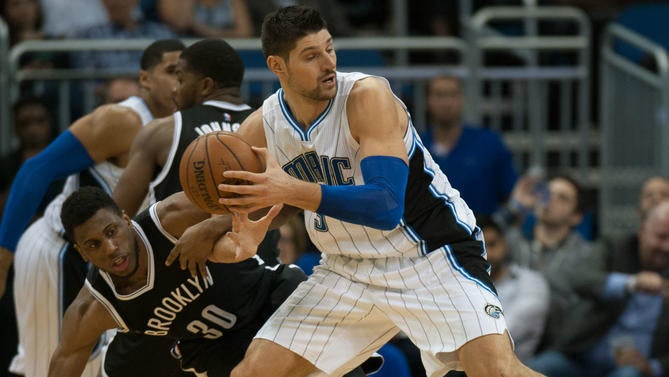
How they project for this season: Here's the good news. The Magic saw their issues defensively and made three big changes. They traded for Ibaka (mentioned right above), they signed Bismack Biyombo, and they hired Frank Vogel to be their coach. All of those moves should vastly improve their rim protection this coming season. Vucevic is still bad at it, but when he has Ibaka to help cover for him and Biyombo to back him up, it seems like less of a problem. Biyombo's numbers last year? 45.2 percent allowed at the rim and 1.72 points saved per 36 minutes (ninth in the NBA). They'll be just fine this season.
 Philadelphia 76ers: Nerlens Noel
Philadelphia 76ers: Nerlens Noel
| Player | Def Rtg Diff. | Rim FG/36 Def. | Rim Def. FG% | RA Rate Diff. | RA FG% Diff. | Points Saved/36 |
| Noel | -2.1 per 100 | 10.1 FGA per 36 | 48.6% | +2.0% | +1.3% | 1.03 Pts per 36 |
How they were last season: This defense wasn't as good as we saw the season before but Nerlens Noel still continued to impress as a rim protector. His numbers at the rim and around the basket (46.5 percent) were both very solid numbers. Having over one point per 36 minutes saved is pretty good considering how bad this team was and they were more than two points better per 100 possessions on defense with him in the game. His defensive abilities/impact can be a bit overstated at times but that doesn't mean he's not very good rim protector for so little experience in the NBA.
How they project for this season: This is a good question. The Sixers have been looking to deal him and possibly Jahlil Okafor as well, which makes you wonder just how highly the consider Noel's potential impact to be down the road. That means they could be relying heavily on Joel Embiid to be their main big man or moving that way, and we just don't know how he'll be defensively right away. If Noel sticks around, he should still be pretty good at this and the Sixers will benefit defensively around the rim having him there.
 Phoenix Suns: Alex Len
Phoenix Suns: Alex Len
| Player | Def Rtg Diff. | Rim FG/36 Def. | Rim Def. FG% | RA Rate Diff. | RA FG% Diff. | Points Saved/36 |
| Len | -3.4 per 100 | 8.8 FGA per 36 | 50.6% | +1.1% | -1.2% | 0.13 Pts per 36 |
How they were last season: Is it a bit surprising to see Alex Len as their main rim protector instead of Tyson Chandler? Chandler has lost a step or two and Len really blossomed in trying to steal the sunshine of opponents attacking the rim last season. Mostly, Len was very solid in rim protection. He didn't save much for points but he didn't have a negative number on the fifth worse defense in the NBA. His 50.6 percent allowed at the rim wasn't that bad and the defense allowed 105.2 points per 100 possessions with him on the floor. That's not great but it's not truly awful either.
How they project for this season: I have no idea. They fired their defensive assistant Mike Longabardi last season before they removed Jeff Hornacek. Under Earl Watson this team was awful but they also had no reason to be good either. They need health and they need to build continuity. It won't help having young bigs like Marquese Chriss and Dragan Bender, but Len should be able to still hold his own no matter what.
 Portland Trail Blazers: Mason Plumlee
Portland Trail Blazers: Mason Plumlee
| Player | Def Rtg Diff. | Rim FG/36 Def. | Rim Def. FG% | RA Rate Diff. | RA FG% Diff. | Points Saved/36 |
| Plumlee | +3.1 per 100 | 11.1 FGA per 36 | 52.5% | +2.3% | -0.1% | 0.23 Pts per 36 |
How they were last season: Despite pretty much being a Cinderella story in the Western Conference, the Portland Trail Blazers were pretty bad defensively. They had a lot of young big men trying to protect the paint while still building an understanding within the scheme and building continuity with their young teammates. It also didn't help than their backcourt routinely got hung up or befuddled by perimeter screens. Mason Plumlee simply couldn't make up for the mistakes. He allowed a high percentage, the defense was worse with him on the floor, and he didn't save many points.
How they project for this season: Can Plumlee be much better in his second season in Portland? The Blazers would benefit greatly from him using his size and athleticism to hone in on proper rim protection. He'll have a very good rim protector coming off the bench in Festus Ezeli, as long as he can be healthy. That should help the overall impact of the defensive interior, but they need Plumlee to be a presence at the rim. They can't just rely on offense if they want to make another leap.
 Sacramento Kings: DeMarcus Cousins
Sacramento Kings: DeMarcus Cousins
| Player | Def Rtg Diff. | Rim FG/36 Def. | Rim Def. FG% | RA Rate Diff. | RA FG% Diff. | Points Saved/36 |
| Cousins | -4.5 per 100 | 8.9 FGA per 36 | 50.4% | +11.3% | +0.4% | 0.00 Pts per 36 |
How they were last season: First and foremost, you can't stress enough how nonsensical the Sacramento Kings' perimeter defense was last season under George Karl. They never "ICE'd" the ball handler and simply allowed them to attack the middle of the floor time after time. This left everybody within the defensive construct out of position. That makes it a bit tricky to truly analyze how DeMarcus Cousins was as a rim protector. His NBA.com number had him allowing 50.4 percent at the rim; his Synergy Sports number had him allowing 45.9 percent around the basket. The Kings were bad defensively but 4.5 points better with Cousins on the floor. He saved exactly zero points -- giving him a neutral impact in that respect. The alarming number is the Kings gave up 11.3 percent more restricted area attempts with Cousins in the game, but again the nonsensical defensive scheme probably is the reason.
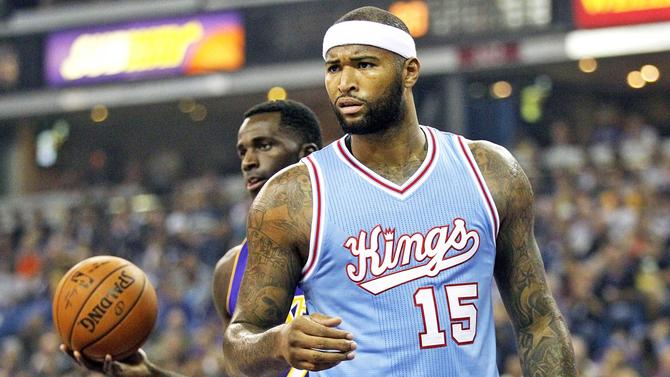
How they project for this season: Exit George Karl and enter Dave Joerger. The Kings will have a much better defensive scheme and they have added guys like Anthony Tolliver and Matt Barnes to help with defensive presences. They also added Arron Afflalo but he hasn't been a good defender in two years -- however, he has the ability to bounce back. The Kings should be much better and Cousins' experience with Team USA should help him understand what it takes a lot more. The Kings won't be nearly as bad as they were defensively and protecting the rim, but they still have to prove they can be good.
 San Antonio Spurs: Tim Duncan
San Antonio Spurs: Tim Duncan
| Player | Def Rtg Diff. | Rim FG/36 Def. | Rim Def. FG% | RA Rate Diff. | RA FG% Diff. | Points Saved/36 |
| Duncan | -4.6 per 100 | 10.0 FGA per 36 | 47.0% | -2.0% | -1.2% | 1.53 Pts per 36 |
How they were last season: For most of the season, the San Antonio Spurs were flirting with being the best defense of the 3-point era. They ended up simply being one of the best defensive teams in the rule change era (since 2004-05). With Tim Duncan anchoring the defense, they were absurd. Despite being Andre Miller's age, Duncan was a highly effective rim protector and the defense gave up a ridiculous 93.8 points per 100 possessions with Timmy on the floor. He saved 1.5 points per 36 minutes and the Spurs allowed fewer shots in the restricted area with him in the game.
How they project for this season: Remember how weirdly effective Pau Gasol seemed at the rim this past season? Well, he joined the Spurs this summer and will presumably take Duncan's place in the starting lineup next to LaMarcus Aldridge. Gasol should still be very solid within the Spurs system when defending the rim. Having to switch to the outside will be much different but he should be fine inside. One sneaky option, even though he's unlikely to start, is backup big man Dewayne Dedmon. He was 21st in points saved per 36 and allowed less than 47 percent at the rim the past two seasons.
 Toronto Raptors: Jonas Valanciunas
Toronto Raptors: Jonas Valanciunas
| Player | Def Rtg Diff. | Rim FG/36 Def. | Rim Def. FG% | RA Rate Diff. | RA FG% Diff. | Points Saved/36 |
| Valanciunas | +5.5 per 100 | 10.7 FGA per 36 | 52.2% | +4.5% | +0.2% | 0.24 Pts per 36 |
How they were last season: Jonas Valanciunas was not a very good rim protector this past season. We saw a big dip in his effectiveness from the previous season when he was allowing just 46.5 percent at the rim, and the Raptors were way more effective defensively when Bismack Biyombo was on the floor and protecting the paint. He ended up missing a bunch of games due to a thumb injury, and it's likely that lack of time on the court led to conditioning issues that left him a step slower defensively. Two seasons ago, he was saving 1.5 points per 36 minutes. Last season, he didn't even get to a quarter of a point. Was it an outlier or was it the beginning of a defensive decline for the 24-year old?
How they project for this season: I'm expecting a bounce back season for Valanciunas defensively. I've said this with a few guys, but it rings true with every single one. As long as he's healthy, we've seen him be a much more effective rim protector than what he was last season. The Raptors also don't have a great backup option to bring in to right the defense now that Biyombo is in Orlando. So they greatly need Valanciunas to be a defensive monster. Dwane Casey is great at devising a scheme to make it happen; he just needs his big man on the floor consistently.
 Utah Jazz: Rudy Gobert
Utah Jazz: Rudy Gobert
| Player | Def Rtg Diff. | Rim FG/36 Def. | Rim Def. FG% | RA Rate Diff. | RA FG% Diff. | Points Saved/36 |
| Gobert | -3.1 per 100 | 9.3 FGA per 36 | 41.0% | +0.8% | +0.4% | 2.03 Pts per 36 |
How they were last season: Rudy Gobert is the best rim protector in the NBA. Opponents talk about how much he changes for them when trying to attack the basket. You see angles attempted that guys normally don't try and arcs on shots inside seem to go a bit higher than normal. Even with his knee injury that robbed him of some time on the court, he had the sixth highest points saved per 36 minutes and the best field goal percentage allowed at the rim of anybody in this post by over 2.5 percent (Ibaka).
How they project for this season: The knee sprain for Gobert in the middle of last season limited some of his mobility, so we saw a little dip in his effectiveness around the rim and he was still the best in the NBA at it. Assuming he's healthy this season and it was just a fluke, he could have the Jazz as the best defensive team in the NBA and opponents dreading bringing the ball inside against him. The Jazz want to slow the pace to a crawl and dare you to challenge inside. They trust their French big man will protect the rim better than anybody.
 Washington Wizards: Marcin Gortat
Washington Wizards: Marcin Gortat
| Player | Def Rtg Diff. | Rim FG/36 Def. | Rim Def. FG% | RA Rate Diff. | RA FG% Diff. | Points Saved/36 |
| Gortat | -1.4 per 100 | 9.4 FGA per 36 | 50.8% | -4.1% | +3.6% | 0.20 Pts per 36 |
How they were last season: The Wizards had a bit of an identity crisis with the way they tried to move to small ball and the injuries to the team certainly didn't help. But Gortat was still a mostly positive force on defense and at the rim. While NBA.com had him just above 50 percent allowed at the rim, Synergy had Gortat at 43.8 percent allowed around the basket. The Wizards gave up fewer attempts in the restricted area by four percent with him on the floor. And the team was nearly a point and a half better defensively overall when he played.
How they project for this season: I think Gortat could be poised for a really impressive defensive season under Scott Brooks. Twice in his final three seasons, Brooks' Thunder teams were top 5 in defensive rating. Granted, the Wizards don't have quite the personnel that the Wizards possess, but Gortat is already a solid presence at the rim and could potentially be in a much better scheme. As long as the Wizards are healthy, Gortat could help them move firmly into the top 10 in defensive rating.















